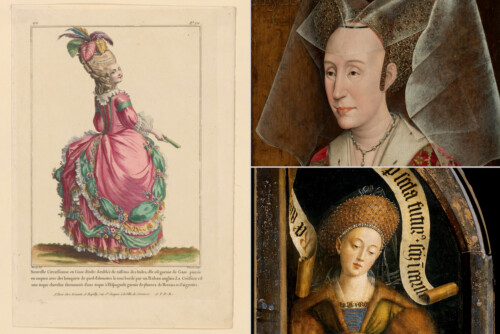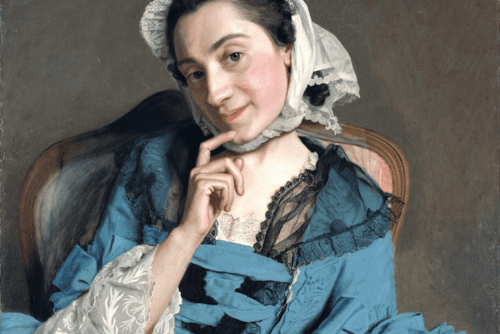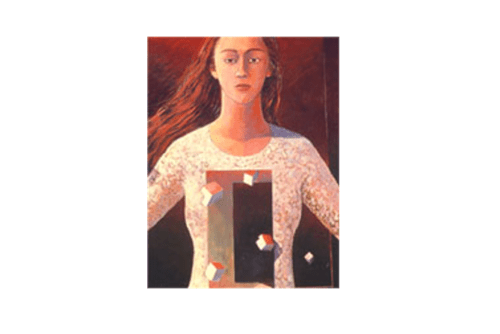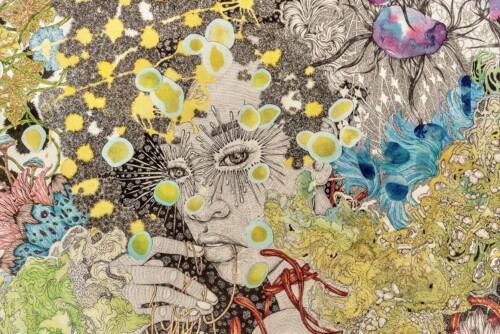Part Two: Enlightened Collaboration
The cultural phenomenon of the eighteenth-century Enlightenment evolved, at least in part, as a result of shifts in the social practices of the elite. The court of the seventeenth century was situated almost exclusively within the spaces inhabited by the royal family and attendant nobles, especially Versailles; social gatherings of the eighteenth-century elite took on a wider range of configurations and purposes. In recent years, studies of eighteenth-century salon culture point to the need to understand the diversity and complexity both of the spaces in which social activities took place, and of the participants’ relations and behaviors. These associations constituting the beau monde included salons in private homes and collectives of individuals in public spaces who cultivated common cultural interests that included literature, theatre, the arts, history, philosophy, and science. The physical space of the salon in private homes, which in the seventeenth century was a more exclusively aristocratic sphere with limited purpose, came to be a forum for the Republic of Letters and the ideas of the Enlightenment. This community demanded of its members qualities that required both strict conformity and personal distinction. Of primary importance was honnêteté, requiring careful observance of good manners, cultural learning that was not pedantic, and the ability to converse with a mastery of language, tact, and wit. These formed the indispensable mondanité – worldliness – that is, belonging to polite society of Paris, the beau monde, the international hub of culture. Finally, anyone who aspired to lead by holding a salon in their home had to demonstrate hospitality and a talent for governing a diversity of personalities and orchestrating harmony for the ever-changing groups. The eighteenth-century salon promoted self-fashioning but within a (generally) imagined ideal of equality, reciprocity, and rational exchange.9
Women were essential to the functioning of the beau monde and of salon culture, but close examination of their myriad roles belies over-simplification of their situation.10 Valued as the ultimate arbiters of good taste and judgment, and as natural sources of the required elements of hospitality and sociability, women brought together and sustained the interactions of the salon community. Intelligence, the right kind of education, and wit were necessary for any woman who assumed such a critical role. However, they also had to negotiate a place that respected the dictates of social decorum specific to their gender; this meant avoiding any hint of learnedness in their interactions, and especially the exposure and self-promotion of publishing. There was a tension between the expectations on women to be active in the community and the dominant conservative attitudes that limited them to the domestic sphere. This presented a challenge for any woman who aspired to intellectual exchange with any depth or who wanted to share her thoughts in print. And yet some salonnières demonstrated a restlessness at the restrictive, conventional roles prescribed for them and a desire to fashion a more active identity for themselves and women in general. In the second part of this volume, the contributors focus women who surpassed what was normally expected of or accepted from their gender, doing so not with open rebellion or dissent, but by capitalizing on the prevailing social ethos of the community.
One figure who lived the paradox of the elite woman of letters was Louise d’Épinay, a collaborator of important thinkers such as Rousseau and Diderot and a prolific writer who saw only one of her own works published during her lifetime. Among the intellectual activities of d’Épinay was her anonymous participation from 1755 to 1783 in the Correspondance littéraire, directed first by Friedrich Melchior Grimm and later Jacques Henri Meister. This clandestine newsletter of politics and culture circulated among a very small number of the northern nobility between 1753 and 1813, with subscribers such as Catherine II of Russia and Louise, Queen of Sweden. It had as its raison d’être the formation of an imagined and elite community, worldly and discriminating, and the creation of a dynamic of dialogue for the pleasure and enlightenment of a very exclusive readership.
In her essay “A Distinguished and Anonymous Female Presence: Louise d’Épinay and the Correspondance littéraire‘s Imagined Community,” Mélinda Caron discusses how d’Épinay assumed a persona with the aristonym “Mme ***” and contributed to the Correspondance littéraire, both as the author of a variety of texts and the recipient of letters and poetry over twenty-eight years.11 By examining two distinct periods of d’Épinay’s work, Caron gives precision to the development of the implied community of the newsletter and of the identity that d’Épinary created for herself in its pages. The role she played as Mme *** in the earlier period of poésie de circonstance (1755–71) was that of a femme galante, a woman whose taste, discretion, and wit established a tone of worldly sociability essential to purpose of the Correspondance littéraire. In her later contributions in the forms of book and theatre reviews, as well as fictional conversations, Mme ***’s authority as critic reinforced an aura of exclusiveness. Central to Caron’s argument in this exposé is the literary representation of social exchange used to foster a sense of community, and the critical element of the woman’s authorial (albeit anonymous) voice in that illusion. Finally, Caron introduces the issue of how d’Épinay used her participation in the Correspondance littéraire as a creative laboratory, a kind of textual space where she could try out the ideas she would articulate more fully in later works such as the discussions on education in Conversations d’Emilie (1783), and the posthumously published novel Histoire de madame de Montbrillant.
d’Épinay’s secret identity as Mme *** epitomizes the situation of Enlightenment women whose presence and voices, often behind the scenes, guaranteed a veneer of feminine sociability to their community. The fact that d’Épinay did not have the financial means (or perhaps even the inclination) to hold social gatherings in her home, may have in fact allowed her greater liberty to engage in a more committed way in a truly intellectual community and to see her work printed. Women who were themselves the maîtresses de maison of the Parisian salons and therefore the organizers of a significant part of the social activities of the beau monde, ran an even greater risk of ridicule if they circulated anything that bore their name beyond letters or the occasional witty word game. There were a few notable salonnières who dared to both host salons and also have their creations attributed to them. One early example is Mme. du Boccage (1710–1802), who published in her name a tragedy, an epic, and even a translation of Milton’s Paradise Lost. However, this exposure came at the cost of being the target of satire at the hands of the likes of Grimm and Voltaire.12
With a contribution entitled “A Salon Hostess’s Entry into the Literary Field: Fanny de Beauharnais and the Members of the School of Dorat (~1770–1780),” Chanel de Halleux discusses the double identities of her subject who was both a salonnière and a published writer. Countess Fanny de Beauharnais, who, after separation from her husband, established a salon in her father’s Parisian hotel in 1762, is best known for her part in the ongoing Querelle des Femmes, a public debate since the late Middle Ages on the nature of women and their roles in society. de Beauharnais contributed a number of writings to the querelle, including a pamphlet entitled À tous les penseurs salut (1773) which de Halleux analyzes for its deft use of antiphrasis, a device to highlight the irony of the hypocrisy in contemporary detractors of women. The countess was indeed an adept writer who mastered the rhetorical and poetic skills of the Enlightenment literary milieu; this is demonstrated not only in her proto-feminist writings, but also in a rich publication career from 1772 to 1811 that included poetry, narratives, and theatre. de Beauharnais strove to establish a new social identity for women, one that would reverse their confinement to the private sphere of home and family.
de Halleux examines de Beauharnais’s personal trajectory to show that in the development of her double identity she was aided by the male authors who frequented her salon, and who supported and furthered her emergence as a writer. This was a community de Beauharnais built around herself, in a move that initially respected the parameters set for conventional salon interaction, but gradually broke from them, and especially from the firm stricture against women’s literary production. In particular, the working relationship she formed with a group of poets led by Claude-Joseph Dorat (with whom she also had a more intimate connection), was critical to the launching of de Beauharnais’s work in publication. de Halleux brings together de Beauharnais’s position on women with her “professional” story to demonstrate how she worked with this community in an exchange of power, protection, and promotion. In an arrangement that was well within salon norms, the countess offered the writers who gathered in her salon a physical space in which they could become known and a share in her own social capital, including her network of important contacts. However, in an expansion of the role of salon hostess, she served as one of the male writers’ primary critics; these men documented her contributions as invaluable not only because she exhibited the conventional feminine taste and honesty, but because she demonstrated a developed sense of literary technique, a skill that is amply attested in her own works.
In turn, the male members of de Beauharnais’s salon offered outlets for the early publication of her works; the Dorat group were also active publishers and contributors to the most important journals of the day such at the Journal de Paris and the Almanach des Muses, in which the countess’s poetry first appeared in 1772. Her first publications were anonymous, and it was not until 1787 that she would sign her own works. However, early on her male cohorts gave her discursive representation by praising her directly and naming her in their own works. They also penned reviews of her anonymous works in ways that allowed her to make a shift from salon hostess to successful writer. In her analysis of how one woman used the community of the salon to defy gender limitations, de Halleux provides a window onto the mixed-gender networking and reciprocal exchange that allowed de Beauharnais to reconcile the normally incompatible roles of salonnière and author.
The context of salon culture also provided the initial ferment for the varied and impressive textual production of Marie-Geneviève Thiroux d’Arconville (1720–1805), one of the most prolific women writers of the Enlightenment and the subject of Leigh Whaley’s essay “Marie-Geneviève-Charlotte Darlus Thiroux d’Arconville and Community during the French Enlightenment.” An avid autodidact and polymath whose voracity for knowledge knew no bounds, d’Arconville’s oeuvre includes original historical, moral, and scientific works (botany, anatomy, physics, and chemistry); novels and memoirs; and translations from English in those genres with the additions of poetry and theatre. The intensity of her intellectual life was due not to her upbringing or social circumstances, but to her natural inclination and the extraordinary community in which she participated. As her memoirs reveal, d’Arconville was from her earliest life a restless woman, driven by what she describes in her essay “Sur moi” as “le désir de faire et même le besoin” (the desire to do things and even the need for it).13 Her energy and her will to escape a tedious and boring existence of social visits and promenades led her to assiduous, self-guided study of languages, history, and especially science. Her own salon was frequented by Enlightenment figures such as Voltaire, Diderot, Condorcet, and renowned scientists of the day. After a grave illness at the age of twenty-two, she devoted her energy to learning and from there attended the public courses in the sciences at the Jardin du Roi as well as corresponding, and collaborating with scientific minds such as Lavoisier, Poulletier de la Salle, Macquer, and Fourcroy. She also wrote and published, albeit strictly under the cover of anonymity, with works appearing almost every year between 1756 until the Revolution cut short her activity. The space of d’Arconville’s social interaction may have shifted from salon to laboratory and cabinet de travail, but the dynamic of conversation that was part of her earlier more conventional life continued to animate her career as a scholar and an author. To a great extent, d’Arconville’s robust activity was the result of her participation in a community of men of the Academy of Science who provided support, intellectual stimulation, and the stamp of authority.
Previous scholarship has documented the presence of the men with whom d’Arconville worked, but has not necessarily addressed their relations as collaboration or from a community perspective. Whaley does so through a sweeping overview of her activity, with emphasis on scientific exploration. From this angle, we see two strong tendencies in d’Arconville’s work. First, she was committed to intellectual pursuit as a dynamic and transformative exchange nourished by interaction with others. Her translations and original work, especially in the sciences, demonstrate an openness to investigation, sharing, and revision that bears the ethos of worldly sociability. This is further borne out in her moral writings, which communicate a firm conviction in the need for understanding the mutability of the individual and the necessity of adapting to circumstances, including those of one’s community.14 Second, d’Arconville expressed throughout her writing the imperative of working to be utile – useful to society. The motivation to work with and for the collective was the driving force behind her remarkable achievements.
The power of collaboration is brought to the fore in Sonia Coman’s essay “A Community of Women Actors and Artists at the End of the Ancien Régime: The Portrait of Madame Thénard mère in Hermione by Adèle Romany,” which closes this volume. As the title indicates, the connections here are between women visual artists at the turn of the nineteenth century and the women actors whose portraits they painted. Coman documents the intertwined professional worlds of visual and dramatic arts, and how their relationships spilled over into that of the society of the beau monde, and especially that of women, who bought the portraits and displayed them in their homes. On the one hand, the portraits were a way to give social visibility and legitimacy to both artists and actresses; neither of these two groups had easily recognized social identities, and, therefore, they enjoyed a certain flexibility in creating roles for themselves. On the other hand, they were also a way to link those identities to an idealized past that, in an increasingly conservative atmosphere of republicanism, allowed the women to perform a degree of fluidity and freedom they no longer had.
Coman presents an example of this self-fashioning in the relationship between the painter Adèle Romany and the actor Magdeleine Perrin, stage name Madame Thénard mère, who was the exceptionally respectable matriarch of a well-known theatre family in Paris. Romany actively sought to integrate herself into the social milieu of women actors in the years before and after the Revolution. In 1800, she painted Thénard in her role as Hermione, the ill-fated daughter of Helen of Troy and Menelaus of Sparta from Racine’s tragedy Andromaque. The image is that of Hermione at the culminating moment of her tragedy, shortly before she commits suicide over the corpse of the man she loves. Coman’s analysis of the portrait highlights the way the identities of actress and character are at once contrasted and conflated in the spectacle of a body in performance, which the viewer sees and interprets; the product is a unique persona that is tragic yet powerful. The female portrait historié that invited the viewer to read the identities of sitter and character as a complex persona was not limited to actors. From within a larger network of women invested in cultural exploits, Coman offers two more examples: that of the allegorical portrait by Romany of Amélie-Justine Laidin de la Bouterie and a painting of the writer Madame de Staël as the heroine of her novel Corinne by the more widely known painter Elisabeth Vigée LeBrun.
It is noteworthy, as Coman demonstrates, that these networks of women artists and actors were active at a time in post-Revolutionary France in which women experienced constricting social mobility and function. The end of the ancien régime marked the culmination of the kind of openness and liberty they had known in the grand era of the salons, and the conservative turn noted throughout is even more operative in the context of early republicanism. The images of women in the portraits discussed here materialize, with both subtlety and force, the kind of resistance and subversion through performance that Judith Butler signals as potentially present in the performativity of identity.15 Thérand benefited from the fluidity of her profession: in real life, she played the role of a strong mother, grandmother, and model for women actors who strove to be serious and respectable; on the stage, she played the role of a passionate woman who refused to bend and who shocked those around her by the determination and drama of her actions. In her portrait by Romany, these two parts of Thérand met in a representation demonstrating the force of women’s collaboration.
Conclusion
Over the past several decades, one important objective of women’s studies, especially when it turns to the pre- and early-modern periods, has been to give greater visibility to women as subjects of action and change; to this purpose, it has been critical to examine more carefully how women achieved agency in social situations that required them to seek inventive and often indirect means to power. Indeed, the questions raised in the beginning of this introduction – Where do we find women in the early modern era? How do we understand the evidence of their presence? – have been investigated in the past half-century through research and publications that have informed and inspired more than one generation of scholars.16
The essays in this volume of Scholar & Feminist Online demonstrate that there is still much work to be done, and that new approaches are needed, especially in examining how women used collective thinking and action to establish an active presence and a visible role in their communities. Such approaches involve broadening the definitions of community and looking for new evidence. Consider, for example, the conventional activities of an aristocrat like Isabel of Portugal not as distinct and traditional ways of conforming to societal expectations, but as actions that, taken together, point to a broader, more imaginative attempt to constitute an ethos of women’s community. We also see how the textual traces left by women like Schütz Zell or Maintenon provide new evidence of women working within but also contesting certain elements in society that limited their fields of agency. And we observe the critical value of archival work in illuminating the presence of women in what appear to be male-dominated spheres of action, demonstrated here with respect to the Italian academies. Even in social contexts in which women manifest greater visibility, in the salons and intellectual and artistic communities of eighteenth-century France, for instance, we must nevertheless look between the lines to perceive their individual voices and actions. Even in the Enlightenment, women had to work within the shadows of social decorum in order to express themselves and to engage with the collective dialogue. Examining the paths to agency of women like d’Épinay, de Beauharnais, d’Arconville, and Romany allows us at once to attest the contributions of these women as writers, scientists, and artists and to imagine how we might look for similar strategies for the many women whose lives and works have still remain under-explored. The guest editors Christine McWebb, Laurie Postlewate, and Lori J. Walters hope that this volume will spark in the readers the desire to continue the search for new approaches and perspectives, and to think creatively and broadly about the role of community in the history of women.
- For a comprehensive explanation of salon culture in the eighteenth century, see Antoine Lilti, Le Monde des salons: Sociabilité et mondanité à Paris au XVIIIe siècle (Paris: Fayard, 2005); The World of the Salons: Sociability and Worldliness in Eighteenth-Century Paris, trans. Lydia G. Cochrane (Oxford: Oxford University Press, 2015). [↩]
- For useful overviews of women in this culture, see, e.g., Dena Goodman, “Governing the Republic of Letters: Salonnières and the Rule(s) of Polite Conversation,” in The Republic of Letters: A Cultural History of the French Enlightenment (Ithaca: Cornell University Press, 1994), 90–135; Susan Dalton, “Elite Women in the Eighteenth Century,” in Engendering the Republic of Letters: Reconnecting Public and Private Spheres in Eighteenth-Century Europe (Montreal: McGill-Queen’s University Press, 2003), 11–33. [↩]
- Mélinda Caron, Écriture et vie de société: Les correspondances littéraires de Louise d’Épinay (1755–1783) (Montreal: Presses Universitaires de Université de Montreal, 2017). [↩]
- Lilti, Le Monde des salons, 119–20. [↩]
- Marc André Bernier and Marie-Laure Girou Swiderski, eds., Madame d’Arconville, moraliste et chimiste au siècle des Lumières: Édition critique (Oxford: Voltaire Foundation, 2016), 76. [↩]
- Bernier and Swiderski provide an especially relevant discussion of Madame d’Arconville’s personal reflections in her moral writing and in the prefaces to her scientific works in “Présentation Mme. D’Arconville (1720–1805): Récit de soi et discours sur la science au siècle des Lumières,” in Bernier and Swiderski, Madame d’Arconville, 1–29. [↩]
- Judith Butler, Gender Trouble: Feminism and the Subversion of Identity (New York: Routledge, 1999), 177. [↩]
- A foundational and representative example of early work that raises these questions is Becoming Visible: Women in European History, ed. Renate Bridenthal and Claudia Koonz, 2nd ed. (Boston: Houghton Mifflin, 1987), 2–3. Originally published in 1977, fully half of the volume is devoted to women before the nineteenth century. [↩]





